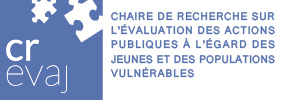[restabs alignment=”osc-tabs-left” responsive=”false” tabcolor=”#008500″ tabheadcolor=”#ffffff” seltabcolor=”#54bc00″” tabhovercolor=”#004c06″]
[restab title=”Area 1″ active=”active”]
Evaluation of the implementation of public policy
In the continuity of a sociology of public action, we propose to de-compartmentalize the analysis of public policies embracing all stages of their progress. We’ll address our interest of the formulation of public problems and their agenda setting by interviewing decision makers about their perceptions of youth and proposed public responses. Our analyses also enroll in a socio-historical perspective of public action. The goal is to keep this close link between the needs at the base of intervention on one hand and public policy implementation on the other. As for the implementation of mechanisms and the logic of professional intervention, we examine them by meeting interveners and professionals. This perspective is original because it transcends and integrates the sectorial studies (education, work and accommodation) and the research related to specific issues (street youth, Aboriginal youth and young immigrants). By focusing on the practical application of support to the young at a local level, the analysis focuses on the processes by which the intentions behind public actions are applied in everyday life. In addition, it captures the adjustments required by the singularity of the characteristics of persons concerned and implementation by local contexts.
Furthermore, public action regarding young people, particularly those in vulnerable situations, must constantly adapt to meet, as adequately as possible, the needs of youth, themselves changing. Therefore, with a comprehensive look on the constitutive process of the development and implementation of public actions, our approach allows an analysis based on a methodological perspective that considers the interactions between the actors involved in the production of public actions. We must then consider the horizontal management issues, intersectoral collaboration and partnership between the actors of public actions and different people surrounding youth in their journey. In this context, internal dynamics of the communities should be highlighted to see how they can be supportive levers or barriers to integration. Finally, the prospect of this axis aims to reflect the diversity of the life situations and support offered in their environment and of the public actions implemented.
[/restab]
[restab title=”Area 2″]
Evaluating the effects of public action
The work of the second axis is to consider the implementation conditions to avoid attribution errors in judgment about the success or failure of public action. The preferred orientation here, to understand the effects of public action, is that of the trajectory analysis and of the analysis of personal networks. Thus, the junction between the biographical and the relational recalls the importance of studying the sequence of events that occur in the different spheres of life to enter the insertion process, particularly in light of the dynamic operation of social networks and their roles. It is thus possible to evaluate how public actions support the transition to adulthood in three integrative social spaces, either work or education, accommodation and family. In this context, work on the actor and his flexibility allows to take into account the role of youth interacting with their environment, recognizing their power over their trajectory and their ability to make choices, to share their point of view of the services they receive and to accept or refuse the support, and that, although social contexts are negatives.
Furthermore, analysis of personal networks allows us to consider the actors, including those of public action, whether present or absent, and how they support or not the individuals. Considering the analysis of the actor’s personal network (primary) as actors from the public action (secondary network) further helps to identify how and to whom to attribute the trajectory changes. Basically, this is beyond the psychologizing approaches that ignore the context in which youth transitions take place (geographical, cultural, economic, social, relational, etc.) to improve social practices and public policies. Therefore, it is of interest to focus on social and relational resilience. Finally, theoretical perspectives on social networks, understood as insertion supporting media, will be used to understand the nature and significance of the relationship between vulnerable individuals.
[/restab]
[restab title=”Area 3″]
Conception and development of news socials practices
Steeped in a comprehensive perspective based on the views of actors, the overall strategy of the Chair also aims to produce other evidence on policy in a “bottom-up” perspective in continuity of the paradigm “evidence informed decision-making.” Resolutely participative, this approach is original and differs epistemologically of a program’s implementation based on expertise and evidence. Our approach takes into account the different organizational, institutional and societal contexts. In order to facilitate a consideration of the individual difficulties and bottlenecks, structural and meso-structural that young people face, we propose a co-construction process, with political actors, managers, professionals of public actions and ideally with young people themselves. Indeed, changes in practices and policies at the center of our projects are complex, given the interdependence and connexion of actors, and that they all have a part of the solution to the problems.
As for our notion of innovations, it relies on the idea that the confrontation of the actor’s paradigms, sometimes opposing or conflicting, allows a rethinking of the problems conducive to an agreement on the nature, the priority and the importance of the changes. Our objective is to bring together producers, intermediaries and users of knowledge to form a collective actor engaged in producing systemic changes necessary for innovation in supporting transitions to adult life of young, surpassing sectoral and organizational issues. Furthermore, the literature emphasizes that scientific knowledge is not independent of the context of production and use, as the ability of an actor to influence the collective environment in which he operates is directly related to the contextual factors in his medium.
[/restab][/restabs]
